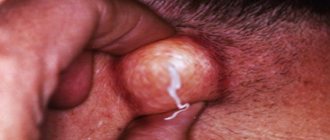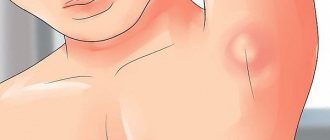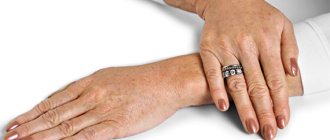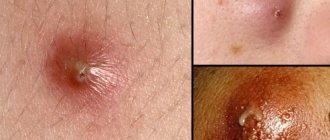Inguinal candidiasis is more often diagnosed in men than in women. The pathology belongs to the category of candidiasis of large folds and is characterized by severe symptoms, causing the patient discomfort and many unpleasant symptoms. The main cause of fungal disease is a decrease in the body’s protective functions under the influence of negative internal and external factors. Treatment of inguinal candidiasis should be carried out under the strict supervision of a physician. An important point is to identify the root cause that provoked the spread of fungal infection. Without its elimination, the risk of the disease progressing to the chronic stage, which is manifested by periodic relapses, increases. Medical specialists quickly diagnose the pathology and prescribe the most effective treatment, taking into account the individual characteristics of the patient’s body. Our doctors pay enough attention to each client to achieve the most positive therapeutic results and prevent complications.
Blisters in the groin with herpes type 2
Herpes can cause pathology not only on the lips, but also on the genitals.
The disease is transmitted through unprotected sexual contact.
Infection of a partner occurs both during active disease and when there are no manifestations.
Symptoms begin with the appearance of grouped blisters containing cloudy liquid in the genital area.
Then they rupture, and erosions and ulcers appear on the damaged area.
A little later they dry out and become crusty.
All periods of rash are characterized by painful sensations.
It is important to remember that the body is never completely free of the herpes virus.
A complete cure will not occur even with complete and competent therapy.
Therefore, a single appearance of herpetic blisters in the groin always leaves a risk of repeated rashes.
Recurrences of herpes infection are possible under the following conditions:
- other infectious diseases;
- exacerbation of chronic diseases;
- decreased level of immunity;
- hypovitaminosis;
- hypothermia;
- dysbacteriosis.
In each case of exacerbation, the best way out of the situation is to consult a doctor.
You should not be treated without prior consultation.
Candidiasis in the groin area
The causative agent of candidiasis in the groin area is a yeast-like fungus of the genus Candida, which belongs to the opportunistic microflora and lives on the skin and mucous membranes of every healthy person. With natural balance and proper functioning of the immune system, the infection is in a latent state and does not provoke the development of pathological processes. But as soon as the immune defense fails, the fungi are activated and begin to multiply unhindered, causing the formation of deformable surface changes, accompanied by pathological symptoms.
Common causes of candidiasis in the groin area are:
- obesity, accompanied by the appearance of large folds on the skin;
- endocrine, hormonal disorders;
- failure to comply with personal hygiene rules;
- uncontrolled use of certain groups of medications;
- unbalanced diet, predominance in the diet of foods containing large amounts of carbohydrates and sugar;
- infection through close contact with a carrier.
At the initial stage of development of inguinal candidiasis, the affected skin changes color to a darker one. Then the skin becomes covered with a small blistering rash. The spots have a clear outline. The areas where the blistering rash has formed begin to crack over time, forming erosions and ulcers. Injury is accompanied by unbearable itching and pain.
Fungi of the genus Candida produce a specific enzyme that accumulates in places of infection in the form of a thick, curdled mass. A whitish coating is a characteristic symptom of candidiasis and allows the dermatologist to differentiate the pathology. Treatment of candidiasis of the groin area must be carried out immediately, otherwise the disease will become chronic, accompanied by periodic exacerbations.
Blisters in the groin with herpes in pregnant women
The appearance of blisters in the genital area during pregnancy is dangerous for the unborn child.
Especially if the symptom is caused by the herpes virus.
This can lead to infection of the baby in the womb.
This situation threatens the development of the newborn.
Infection occurs during childbirth.
The infection is more severe than in the mother.
This is due to the fact that the child’s immune system is not perfect.
Therefore, it is necessary to diagnose and treat genital herpes in a woman during pregnancy.
The disease is characterized by blisters with cloudy liquid.
They are located in groups on the genitals.
The woman experiences pain and discomfort in this area.
Then the bubbles burst, leaving erosions and ulcers in their place.
The diagnosis can be made through laboratory testing of the contents of the vesicles.
Herpes virus type 2 is detected.
Treatment occurs locally with antiviral ointments and drugs to strengthen the immune system.
Groin rash in men: additional symptoms
Rashes in the genital area in men manifest themselves in different ways. The type and nature of the rash depends on the cause of the dermatological reaction. The rash can be small or large, red, white, pink. The affected areas often disturb the patient with itching or bleeding. Sometimes the blisters burst and serous fluid leaks out.
The clinical picture is often complemented by the following symptoms:
- pain in the perineum, especially in the testicles;
- itching in the genital area;
- pain and burning during urination, ejaculation;
- swelling of the scrotum and penis;
- cracks and wounds on the inner thighs;
- peeling of the skin and formation of scales on the mucous membranes;
- redness of the anus;
- open wounds of the perineum that do not heal for a long time;
- pain during intercourse;
- the appearance of blood in semen and urine;
- increased body temperature;
- muscle and headaches;
- general weakness.
The set of warning signs is always different, since the clinical symptoms of each disease are individual.
Blisters in the groin due to scabies
The risk group for groin scabies is men.
The most common location of scabies is the hands, from there it spreads to the penis.
Normally, blisters do not form with scabies.
The rash consists of blisters and papules.
The bullous form with blistering is rare.
The severity of scabies is not related to the number of mites.
It depends only on individual allergic reactions to pathogens.
A more common cause of the development of blisters is the addition of a secondary infection.
It occurs against the background of scratching in the groin.
Scabies causes severe itching.
The genital area contains a large number of bacteria.
Secondary infection develops relatively often.
The main therapy for scabies is carried out with antiscabiosis drugs.
Previously, special talkers were used for this.
The treatment took up to a week.
Now there are modern means.
They get rid of parasites in 1 – 2 applications.
Secondary infection, if present, requires additional therapy.
Rash in the intimate area in men: sexually transmitted infections
Sexually transmitted diseases are the most common cause of groin rash in men. The infection affects the genitourinary tract and spreads throughout the urogenital tract.
The appearance of rashes on the glans penis, on the skin of the foreskin, and in the scrotum area may be associated with the following sexually transmitted infections:
- Syphilis.
The disease begins with the formation of a small ulcer on the head of the penis. Over time, the wound heals, but small red rashes appear in the groin area. A red rash on the glans in men indicates infection, possibly Treponema pallidum, which causes syphilis. A small red rash on the head in men with syphilis is observed at the initial stage of the lesion. In the absence of adequate treatment, the disease takes a severe course. The nature of the syphilitic rash in men changes. Ulcers, small nodules, and red spots appear on the penis and perineum. The disease is very dangerous because the bacterium affects the genitourinary organs, mucous membranes and nervous system; - Chlamydia.
This disease is caused by a pathogenic bacterium - chlamydia. Chlamydia rashes appear after a severe weakening of the immune system or the addition of a secondary infection. The rash on the penis in men looks like dense nodules. As the disease progresses, the pimples become covered with scales and merge into a single spot. Chlamydia is dangerous for sexual dysfunction and infertility. The disease can be asymptomatic for a long time, so if you have any unusual symptoms, it is important to consult a doctor immediately. - Genital herpes
. Develops when infected with herpes virus type 4. The disease affects the entire surface of the genital organ. Genital herpes in men manifests itself as small blisters filled with serous fluid. After 2-3 days, the bubbles burst, involving the skin adjacent to the affected area in the pathological process. Over time, the rashes form large, weeping wounds. A genital herpes rash can persist for months without adequate treatment. The rashes are itchy and painful. This inevitably negatively affects the physical and psychological state of a man. The disease cannot be cured, but preventive measures can prevent exacerbation and prolong remission. - Gonorrhea
. The disease is caused by gonococcal bacillus, which multiplies on the surface of the epidermis. In this case, a red rash in the groin of men appears near the sites of infection. The rash is an early sign of gonorrhea infection. The first pimples appear on the head of the penis and the frenulum of the foreskin. The bacterium affects the urogenital tract and is able to penetrate the patient’s blood. The latter is dangerous due to the spread of bacteria throughout the body and damage to internal organs. - Trichomoniasis
. The disease almost always occurs without symptoms, so in most cases it takes a chronic form. With chronic trichomoniasis, a red rash appears on the penis and testicles. The rash is constantly itchy and can spread to the entire perineum. The disease is accompanied by pathological discharge from the urethra. - Human papillomavirus.
The presence of the virus in the body is detected in every second patient. In men, the disease manifests itself as rashes in the form of genital warts. Sometimes the rashes look like small white pimples. Condylomas appear on the head, foreskin, shaft of the penis, scrotum, pubis, and around the anus. Warts are usually painless, but they can become injured if they come into contact with clothing or during sex. This causes discomfort. HPV requires constant medical monitoring, since the papilloma virus is the main cause of genital cancer.
A rash due to STDs in men requires immediate specialist intervention. The doctor will prescribe the necessary tests to determine the type of pathogen. Timely determination of the cause of an unpleasant symptom allows you to choose the right treatment and avoid complications.
Blisters in the groin due to eczema
This disease is chronic and not contagious.
There are many reasons for it, but the exact etiology has not been identified.
Eczematous rashes can be located throughout the body.
During an exacerbation, bubbles with liquid form on the skin.
They burst, and erosions and crusts form in their place.
There are several stages of eczema:
- skin hyperemia;
- the formation of many small bubbles;
- getting wet;
- formation of crusts.
Any area of the skin can be affected, including the groin folds.
The disease causes severe itching in the affected areas.
The course of the disease follows the type of exacerbation - remission.
For eczema, a mandatory visit to a doctor is recommended.
Rash due to syphilitic infection in women
Syphilis is an infectious disease that is sexually transmitted. This is a dangerous and serious disease that affects the genital organs, liver, and nervous system. Without adequate medical care, a person becomes disabled or dies.
Sexual infection appears 1-2 months after infection. Its first sign is the formation of a dense, hard chancre on the labia or vaginal mucosa. This is the main symptom of the onset of the inflammatory process. After 4-6 weeks, the solid formation disappears. An imaginary feeling of recovery appears.
In fact, at this time the infection is already spreading throughout the body. This is evidenced by a small pink rash in the groin area in women, which appears after 5-10 days. The rash also affects the mucous membranes of the mouth and eyes. With syphilis, small dense condylomas also appear in the intimate area. They are located mainly on the labia and anus.
The rash with syphilis in women does not itch or hurt. The infection is accompanied by abnormal vaginal discharge. Leucorrhoea contains impurities of pus, becomes thicker, and has an unpleasant odor. Whitish papules, ulcers and purulent discharge are characteristic signs of the second stage of syphilis.
In the third stage, the characteristic rash spreads throughout the body. Sometimes the rash goes away, but after a couple of weeks the syphilitic rash in women again covers the entire body.
Blisters in the groin due to dermatitis
Atopic dermatitis is a chronic disease.
As a rule, the first rashes occur in childhood.
Any area of the skin is involved in the pathological process.
The groin area is affected by dermatitis.
The disease is caused by heredity or occurs when the immune system fails.
Numerous blisters appear in the genital area.
They are filled with liquid.
The skin underneath is red and enlarged.
The bubbles burst and crusts form after them.
A distinctive feature of dermatitis is itching.
It intensifies at night.
After the acute process, the following remain:
- hyperemic areas of the skin with crust;
- scales on damaged skin;
- red or brown rash.
The disease progresses with periods of acute manifestations and remission.
To prevent symptoms from returning longer, you need to follow the rules.
When washing, use only hygiene products made from natural substances.
After showering, dry skin until moisture is completely removed.
Use a moisturizer without harmful chemical components.
This will avoid dry skin.
Types of rashes in women
Skin rashes manifest themselves in different ways. There are such types of rashes that affect the skin in the intimate area:
- A pimple
is a small bump or nodule protruding above the general layer of skin. The formation is often filled with serous fluid; - An abscess
is a large pimple with a watery texture. The formation is filled with purulent fluid; - Erythema
- bright red spots with clear boundaries. They stand out strongly against the background of healthy skin; - A blister
is a formation filled with fluid. Occurs due to mechanical injuries, burns; - An ulcer
is a non-healing wound that most often forms on the mucous membranes; - Condyloma
is a small formation of the papillary type on a stalk. Localized on the mucous membrane of the genital organs. - A node
is a dense formation in the deep layers of the epidermis. It appears in the form of a tubercle that protrudes above healthy tissues; - Plaque
– multiple formations in the form of small spots. They rise above healthy skin.
A rash in the groin area in women can simultaneously manifest itself in several types of skin lesions. Each type of rash is a signal of developing pathology, poor hygiene, unsafe sex life or other intimate problems.
Blisters in the groin due to allergies
Wearing synthetic underwear may cause rashes in the genital area.
Food allergies cause blisters on the genitals.
If a person has eaten something allergenic, a rash will appear within 24 hours.
When wearing underwear made from artificial materials, bubbles will appear after skin contact with the fabric.
The rash is accompanied by severe itching and hyperemia.
Often, allergies develop to topical medications.
These include ointments, lotions, creams, and local antiseptics.
Another common cause is contraceptives and lubricants.
Blisters in the groin area can also occur after using intimate toys containing latex.
The size of the bubbles and the severity of the discomfort depend on the severity of the reaction.
In addition to rashes, severe tissue swelling may develop.
Any allergic reaction requires contacting a specialist.
If you have a rash in the groin, you should in any case go to a dermatovenerologist.
This is due to the similarity of the symptoms of these diseases with sexually transmitted diseases.
Allergy treatment depends on the severity of the symptoms and the overall severity of the condition.
The main remedies are to stop contact with the allergen and take antihistamines.
Medicines can be used by injection, orally, and topically.
Sometimes a form of allergic reaction such as urticaria develops.
Blisters appear on the body and are very itchy.
After two to three hours they are replaced by the general reaction of the body.
Nausea, vomiting, and pain in the abdomen occur.
Typically, antihistamines and avoiding contact with the allergen help in this situation.
What treatment therapy should I use?
Before prescribing treatment for inguinal candidiasis, it is necessary to establish an accurate diagnosis and identify the pathogen. Therefore, after an initial examination and history taking, the doctor gives a referral for a comprehensive diagnostic examination, including the following procedures:
- microscopy;
- bacterial sowing;
- molecular biological analysis.
Treatment of candidiasis in the groin should be comprehensive and carried out under the strict supervision of a doctor. Self-medicating with such a disease is dangerous and fraught with serious complications.
The treatment plan includes the following activities:
- Identification and elimination of factors that provoke immunodeficiency.
- Prescription of antifungal and symptomatic therapy.
- General strengthening therapy.
To combat a fungal infection localized in the groin, local antifungal drugs are prescribed in the form of creams and ointments, which contain an antimycotic component. In the fight against fungi, drugs such as:
- "Nystatin";
- "Natamycin";
- "Clotrimazole".
If the disease is advanced and accompanied by serious complications, in addition to topical medications, antifungal medications are prescribed for oral administration in the form of capsules and tablets:
"Fluconazole";
"Itraconazole"
In the most advanced cases, the doctor will recommend intravenous or intramuscular administration of antimycotics. As soon as the condition improves, you can switch to tablets.
In case of correct treatment, the disease completely disappears within 7–10 days. To confirm complete recovery, repeat tests must be taken after completing the main course. If the fungal infection is completely eradicated, the laboratory test results will be negative.
In addition to drug treatment, it is important to follow preventive measures that enhance the therapeutic effect and reduce the risk of relapse to zero. Therefore, together with drug therapy, it is advisable to follow the following rules of prevention:
- strengthen immunity;
- lead a healthy, active lifestyle;
- get rid of bad habits;
- maintain personal hygiene;
- normalize weight;
- use products that control sweat in large folds.
If there is no treatment for inguinal candidiasis, the fungal infection will gradually spread throughout the body, causing health and life-threatening complications. Therefore, if you have suspicious symptoms, you must make an appointment with a dermatovenerologist, take all tests and be treated under the supervision of a specialist.
Which doctor should I see for blisters in the groin?
The occurrence of such a symptom causes discomfort in a person.
Many diseases are accompanied by pain.
It is important to consult a doctor in this situation.
A dermatovenerologist can help with skin diseases.
If the process is caused by sexual intercourse and there is an infectious disease, then the intimate area is affected.
In this case, a dermatovenerologist can help.
There are specialized dermatovenerological clinics.
They treat patients with various skin lesions.
What tests are prescribed for blisters in the groin?
To accurately determine the diagnosis, it is necessary to undergo laboratory tests.
The patient donates blood, which determines active inflammation.
Elevated levels of immunoglobulin E may be detected in the blood.
It indicates the presence of atopic dermatitis or an allergic reaction.
Additionally, skin tests with allergens are performed to determine the cause of these diseases.
When blisters appear on the skin, the immune system is examined.
Many diseases arise against the background of reduced protective properties of the body.
A scraping is taken from the blisters and subjected to various laboratory diagnostic methods.
This is how the herpes virus is detected.
Cytological examination can reveal acantholytic cells.
They appear with pemphigus.
These measures are carried out to make a correct diagnosis.
A correctly identified disease can be properly treated.
The patient gets rid of blisters in the groin area.
Treatment of blisters in the groin
Therapy is determined strictly by the doctor and depends on the cause of the bubbles.
For various types of herpes, antiviral drugs are prescribed.
They are able to remove local symptoms.
At the same time, it is recommended to take a course of immunomodulatory drugs.
Exacerbation of infection and the appearance of blisters is provoked by a weakening of the body's immune system.
When prickly heat occurs, it is important to follow the rules of intimate hygiene.
An antiseptic is applied to the damaged area.
Antihistamines are used against eczema.
To stop the inflammatory process, enzymes and immunomodulators are prescribed.
If swelling is pronounced, diuretics are used.
For local treatment, medications are applied to the damaged area.
Eczema can be triggered by severe nervous tension and stress.
Therefore, it is recommended to use sedatives.
For dermatitis, glucocorticoid hormones are prescribed in local preparations - ointments, creams.
It is important to exclude contact with provoking factors.
Pemphigus is treated with high-dose glucocorticoids.
Hemosorption, cryoapheresis, and membrane plasmapheresis are used.
Weak antiseptics are applied locally.
Common to all diseases is the prescription of a diet.
Exclusion from the diet of spicy, fried, fatty foods.
People with chronic skin diseases are advised to avoid stressful situations.
Rash in the groin in men: causes
The content of the article
Groin rash in men affects:
- scrotum;
- the shaft and head of the penis;
- anus and anal area;
- inner thighs;
- suprapubic area.
The skin of the penis and inner thighs reacts to the spread of infection by changing its structure, since the epidermis in this area is very thin and sensitive. Therefore, when a rash appears, the skin of the genitals changes texture. Hyperemic spots, small blisters, pimples, hollow blisters, ulcers, erosions, etc. may appear. With genital infections, the rash spreads to the mucous membranes and changes their color.
A rash in the perineal area in men may be a reaction to the following changes in the body:
- weakening of the immune system (including HIV infection);
- infection with sexually transmitted infections (staphylococcus, chlamydia, herpes, gonococcus);
- proliferation of opportunistic flora (candidiasis);
- endocrine disorders, changes in the production of sex hormones;
- allergic reaction (to consumed products, contact with synthetic fabric);
- skin diseases (psoriasis, dermatitis).
The following factors contribute to the appearance of groin rashes:
- failure to comply with intimate hygiene rules;
- chaotic sex life;
- refusal of preventive examinations by a urologist;
- refusal to use condoms;
- excess body weight;
- eating exotic food;
- alcohol and tobacco abuse.
Complications
Any blisters in the groin area are a violation of the integrity of the skin.
Bacteria can enter an open wound.
They cause a purulent inflammatory process in the damaged area.
The doctor additionally prescribes antibacterial agents.
Treatment of the main cause of the disease is delayed.
Therefore, it is important to immediately contact a dermatovenerologist if you notice skin rashes in the groin.
He will examine the patient, conduct diagnostics, make the correct diagnosis and prescribe treatment.
This will allow you to get rid of the disease and its manifestations.
Symptomatic picture of mycosis
Candidiasis of the inguinal folds is caused by specific fungi, which are opportunistic microorganisms that live on the skin and mucous membranes of any healthy person. The immune system, functioning without failures, suppresses the active activity of pathogenic microflora, so they remain in a latent state in the human body. However, under the influence of pathological exogenous and endogenous factors, the immune system is weakened and ceases to fully perform its functions. This contributes to the activation of the infection and its unhindered reproduction.
The active activity of a fungal pathogen on the skin in the groin area is manifested by the following pathological symptoms:
- Formation of spots in the groin. The lesions have clear boundaries and differ in color from healthy areas. The shade of the spots ranges from light pink to deep red.
- Peeling of the skin. In places where a fungal infection is localized, the skin becomes covered with a white coating and peels off. Peeling may spread to the perianal and pubic areas, as well as to the folds of skin between the groin and thigh.
- Uncomfortable sensations. In the groin area, the patient is bothered by severe, sometimes unbearable itching, which can cover the femoral part of the lower limb.
- Irritation. Swelling, redness, and irritation form at the site of active fungal activity.
On the skin of the groin area affected by the fungus, round, deformed areas are visualized, which differ from healthy skin in shade and the presence of peeling on the surface. Thanks to such visual signs, the doctor can make a preliminary diagnosis, which will be confirmed by the results of a comprehensive diagnostic examination.
Diagnosis of blisters in the groin
The primary diagnosis of the causes of blisters in the groin area is performed by a doctor during a clinical examination of the patient at an appointment.
He thoroughly determines the time of appearance of the bubbles, the presence of accompanying pain or itching.
The influence on their expression of various physiological processes in the body.
After a clinical examination, based on the results obtained, the specialist prescribes additional diagnostics.
It includes various laboratory research techniques aimed at identifying and identifying pathogenic (disease-causing) microorganisms.
Diagnosis is carried out using:
- microscopy,
- PCR,
- ELISA
- allergen through skin testing (injecting a small amount of a diluted solution of the most common allergens into a small area of skin).
Treatment of blisters in the groin
Effective treatment of such manifestations as blisters in the groin in men or women is possible only after eliminating the impact of the cause of their development.
For herpes infection, various medications are used, which include antiviral drugs.
They come in local (ointments, creams) and systemic (droppers, tablets, capsules) action, active against the herpes virus.
In the case of a diagnosed allergic reaction, the main measure is to prevent repeated contact of the skin of the groin area with the allergen.
To reduce the severity of itching and burning that may accompany the appearance of blisters, anti-inflammatory drugs are used for local use.
If any blisters appear in the groin, contact the author of this article - a dermatovenerologist, urologist in Moscow with 15 years of experience.
Athlete's inguinal
The disease is caused by fungi of the genus Epidermophyton floccosum. The infection is transmitted through household contact and most often affects men. Factors that provoke the development of the disease include:
- wearing tight, constricting clothing that disrupts natural air exchange in the groin area;
- profuse sweating;
- increased environmental humidity;
- frequent injury to the skin in the groin;
- inactive lifestyle;
- excess weight.
In the initial stages of development, the infection is localized in the skin folds of the genital area, but as it progresses it spreads to the upper part of the inner thigh, affecting both limbs. Usually the fungus does not affect the skin of the scrotum.
The rash has a scaly, pinkish border. Inguinal athlete's foot is often accompanied by itching and pain symptoms. Lack of timely treatment leads to an increase in lesions and the spread of infection to healthy tissue.
To prevent the development of inguinal athlete's foot, it is advisable to follow simple rules of prevention:
- wear comfortable underwear made from natural fabric;
- observe the rules of personal hygiene, especially in saunas and swimming pools;
- use personal hygiene items and do not give them to any strangers;
- normalize body weight;
- add moderate physical activity;
- If you have characteristic symptoms of a fungal infection, do not self-medicate, but make an appointment with a dermatologist as soon as possible.











